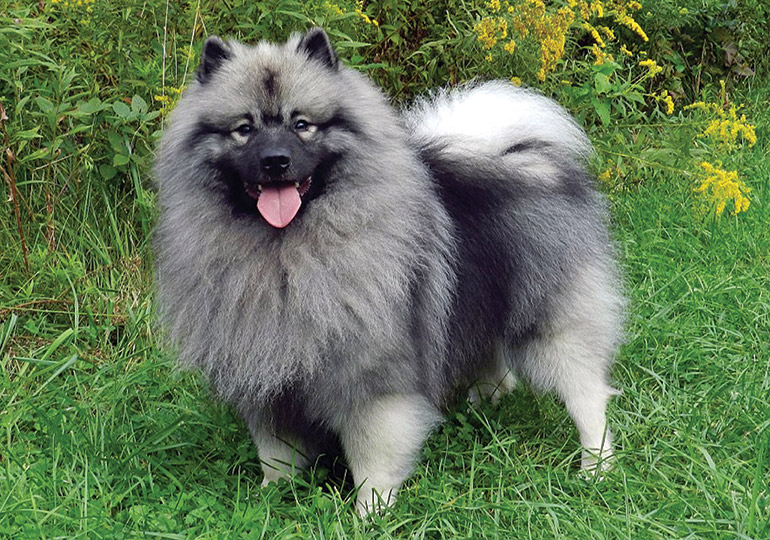Breeds
Keeshond

GROUP 7 - NON Sporting
History
Recognised as a Spitz Breed, the word Keeshond is a two-syllable word, where the first syllable ‘Kees’ derived from the nickname of Cornelius de Gyselaar, the Patriot Rebellion Leader, who we will learn more about below. The second syllable ‘hond’ means ‘dog’ in Dutch and together we pronounce them as Caze-Hawnd.
The smiling Dutch barge dog rode on small vessels that travelled the Rhine River, acting as both watchdogs and companions to barge captains. To carry a dog on a vessel was first considered a good omen and developed into a custom. In time the dog became part of the sea laws, because it came to represent ownership. Their travels made them known well beyond The Netherlands, but they really gained a name during the political turmoil that gripped Holland in the late 17th century. In about 1781, Holland was divided into two political factions: the Orangists (Conservatives), who supported the Prince of Orange as Governor of the Netherlands, and the rebellious patriots (or Keezen, as the pro-Orange men derisively referred to the people’s party members). Cornelius de Gyselaar, who had one of these popular dogs as his constant companion, was a leader in the patriot’s revolt and the Keeshond quickly became the emblem of the Dutch party. Unfortunately, when the Patriots were defeated the dogs’ popularity plummeted.
The development of the Keeshond in Australia really began in 1949 when Mrs Bourne emigrated from England. She brought with her four Keeshonden and these dogs became the foundations of the Australian lines in the 1950s and 1960s.
Temperament
The Keeshonden character has a unique charm that boasts a sense of humour, rarely found in other breeds,and an enjoyment for life which is delightfully infectious. His intelligence exudes from his quick witted and amazingly observant nature and his sheer good looks will make you forgive him every time. Ideal as a child’s playmate he can join in their games, however rowdy and rough, with no fear of getting out of hand. Whether you are looking to enter the show ring, obedience trials, agility trials, flyball trials or adopt a loving family pet, the Keeshond will make an exciting addition to the home lifestyle.
Appearance
The Keeshonden character has a unique charm that boasts a sense of humour, rarely found in other breeds,and an enjoyment for life which is delightfully infectious. His intelligence exudes from his quick witted and amazingly observant nature and his sheer good looks will make you forgive him every time. Ideal as a child’s playmate he can join in their games, however rowdy and rough, with no fear of getting out of hand. Whether you are looking to enter the
show ring, obedience trials, agility trials, flyball trials or adopt a loving family pet, the Keeshond will make an exciting addition to the home lifestyle.
Health issues
The Keeshond is a generally healthy dog with an average life span of 10 – 13 years, although many have lived well into their teens. Health conditions that have been seen in the Keeshond include hip dysplasia, epilepsy, primary hyperparathyroidism, and skin and coat problems. Not every Keeshond will get all or even any of these conditions, but it’s best to be aware of the possibility. A reputable breeder will be honest and open about health problems in the breed and the incidence with which they
occur in their lines.
Suitability & Maintenance
True to his heritage as a barge dog, the Keeshond has moderate exercise needs. He will be satisfied with a walk on leash or playtime in a yard and generally adapts to his owner’s activity level. These traits make him well suited to life in a smaller space.
One caveat: He is a barker. That makes him a good watchdog, but he can easily cross the line into nuisance. It’s essential to teach him when it’s okay to exercise his lungs and when it isn’t.
One of the most striking characteristics of our breed is their harsh, off standing, and straight coat. To the untrained eye at first glance the Keeshonden coat would appear to need many hours of grooming due to its density and profuse coat, however, a 10-minute session a couple of times a week will keep your Keeshond knot free and looking as fabulous as ever. Hence one of the Keeshonden inherited nicknames is the ‘lazy man’s glamour dog’. Grooming not only serves the purpose of coat care and maintenance, but also allows you to monitor your dog’s health and build the bond between you and your pet. It’s also a great time to practice the commands ‘Sit, Stay & Drop’. During shedding seasons into summer and winter, males usually malt their coats once a year and female twice a year, and yes you guessed it - more grooming during these times is required.
Words: Tracey Parker, on behalf of the Keeshond Club of NSW
Image: Dog Breed Atlas
In Conclusion
Now you know a little about the Keeshond, you may think that this is the dog for you. Before you make a decision, please make contact with the breed club or your State controlling body for purebred dogs. They will be able to give you information about available puppies and also suggest dog shows where you can see the breed and speak to breeders. In this way you will gain a better perspective of the Keeshond and its needs, and whether this breed would suit your lifestyle.
Breeders
Sorry, there are currently no breeders advertising for this breed. If you are a registered DOGS NSW breeder and wish to advertise here please create an advertisement here.


